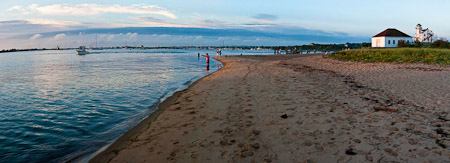In California, where I live, a striped bass might be 15” long and weigh a few pounds. In Rhode Island the legal, aka lower, limit is 28”. In early July, every year since 1994, the Rhode Island Freediving Club has hosted the Rhode Island Bluewater Meet, a big bass spearfishing tournament. The meet was started in honor of Jim Warnock, a young free diver who died while training. If you want to be in the running for a tournament prize, you need to aim for 45” or more.
Block Island is a 10 square mile pork-chop shaped piece of glacial detritus that sits about 10 miles off the Rhode Island coast. Bait collects in its shoal waters and creates a powerful draw for striped bass on their annual northward migration, and for other species, including homo sapiens and various sharks.
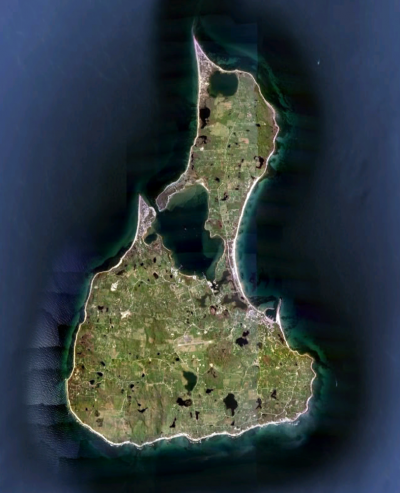
3 miles wide and 6 miles long, its northern tip is about 9 miles south of the coast of Rhode Island.
Sharks aren’t a problem for most divers though. In 13 years of seriously exploring the coast, I’ve only positively identified one shark, a vegetarian Basking Shark, and with a possible sighting of second. Many others have reported sightings, and a half dead Thresher Shark, or was it a Nurse Shark, was all washed up on beach July 4th weekend. A very reliable report exists of a Hammerhead Shark swimming in Block Island’s New Harbor, or Great Salt Pond, in the 1960s. In the deeper waters between Block Island and Newport to the Northeast and Montauk to the Southwest, large sharks abound, but that’s a different and well told story.

The aforementioned shark washed up within 400m the crowd in this photo. Shown here is a massive, messy beach party, now a 3 year old July 4th tradition with more than a little controversy about it, too.
The water is clear too, often with visibility of 25’ or more, and free dive spearfishing has become very popular.

On a very very still day in June, 2011, you can see to the bottom in 30' or more of water off of Charleston Beach on the West Side of Block Island.
I remember a day 10 years ago when I saw a guy in full body wetsuit walking up a steep trail carrying two big stripers. I asked him about them. In a few minutes I was hooked. I bought some gear, a book, and eventually a boat. I had realized that a boat is a lure for fishing talent, and if I wanted to learn, I needed teachers.
As it turns out, that guy, Brian, coming up the trail was no chance amateur, but a world-class spearer, and a two time winner of the Warnock Tournament. This is now our 10th year of fishing together.
That he was coming up that trail, and not some other trail, was no coincidence either. The trail provides access to a spot where a 19th century New Yorker by the name of Barlow found the striper fishing so sublime that he built a vacation home a short walk from the trailhead. Erosion has taken its toll, and the stripers were nearly fished to extinction a few decades ago, but you wouldn’t know it these first few days of July 2011.
Barlow’s Point holds fish as big as 30 lbs, but that’s not what you need to place in this tournament. Recently, the contest has been won with fish over 50 lbs. To find fish of that size, there are a few spots that were once the sole province of rod and reelers, but have recently been explored by free divers.
So it came to pass that in the week leading up to this year’s tourney, Brian was sussing out the best of those spots, and I had the pleasure of going with him more than once. Early in June, a rod and reeler had set a new striper record for Rhode Island, 77.4 lbs! While what he said about it in The Block Island Times might have been all fish tale, we went out there to scout, and we were not alone in our premeditations.
Early in the beautiful morning of July 7, we drove on down to The Boat Basin to board my little boat.
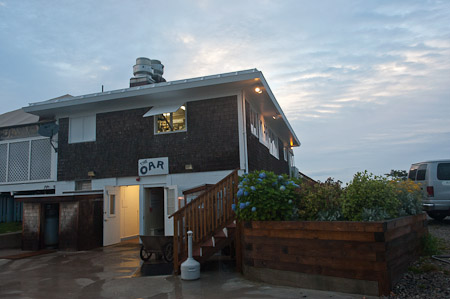
The Oar is a fine establishment for eating, watching the boats and the weather, or using the public bathrooms. We stop there to drop off our gear.
On rolling but nearly glassy seas, we found ourselves in the company of exactly one other boat, and they were spearing. We pulled up alongside them, right friendly like. Some people would have felt like we were encroaching, but in this small world all the experienced players know each other, and Brian indeed knew the other two. One was Dave Hochman, the reigning world record holder for stripers. The other, John Warnock, as in the eponymous tournament, Brian described as a legend. Like Brian, he was a two time winner of the tournament.
Here’s a short course in free dive spearfishing. Take a deep breath and hold it while you dive to the bottom. Wait while the disturbance you’ve created subsides, shoot a (legal) fish when it swims within a couple of meters from you, and swim to the surface. There, wrestle it to submission. Repeat. And what is that I meant when I said shoot? Think of a crossbow with two important differences. Power is supplied by (large) rubber bands instead of a bow, and the meter long barbed steel spear is connected to the gun with short wire or a long rope. And that phrase “dive to the bottom” holds a lot of mystery, as the bottom might be very far away and not at all visible from the surface.
Leaving Hochman and Warnock to themselves, we found a spot of rocks in 30’ of water and let the boat drift with the current. Our fishfinder, a device that reads anomalies in the sound waves projected to and reflected from the bottom, and then displays those anomalies as fish on a screen and beeps from a speaker, was on fire, showing large schools of fish in mid-water. “Dogfish” “Dogfish?” “Yes, dogfish, sandsharks, if they’re schooling like that.” Moments later, “Stripers!”. The stripers tend to hang out on the bottom. The current was moving at 2 knots, or 1.2 ft/s, and after a time, the water was more than 50’ deep. I might be able to touch at 50’, but I can’t hunt, so that point marked the end of the drift for us.
We motored back to the original spot and both hopped in the water, letting the boat drift along with us. I should say, Brian hopped in and while I was getting the last details of my gear in order. He did one dive and returned with a 40 lb striper. I helped him get it on board, and then got in myself. When there’s no wind and few other boats to worry about, and you have strong divers, and they and the boat are carrying dive flags, then drifting with the boat in this manner is very easy and seems safe.
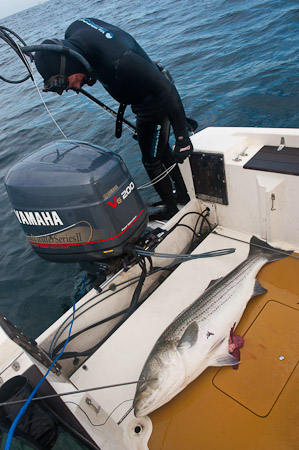
Moments after getting in the water, Brian was back with a 41' striper. We weighed it, so that number is for real.
It took me a while to get my bearings, as all the diving I’d done this season was in 30’ or less of water. But conditions were ideal and it wasn’t long before I was able to get down to the bottom and watch the fish come and go. Dogfish in midwater, stripers and tautog near the bottom. Not much else besides seaweed on rocks amidst the sand. On one dive, gasping for breath as I reached the top, I came up to find Brian in the boat next to me. “What’s the depth?” “55 feet.” “Okay, that’s why I can’t get all the way down!”
On the morning of July 9, we went to the docks before sunrise, loaded up The New Normal, and headed out to the same spot. There were already several other boats out there. It being both a Saturday and tournament day, there were plenty of rod and reelers in addition to the spearers. There might have been 30 boats out there by the time we left nearly 4 hours later.
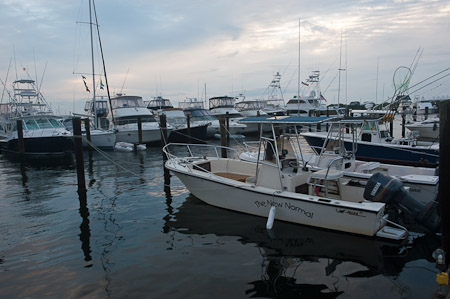
This is a great fishing platform, not one I'm worried about getting covered in blood. A 23' Mako built nearly 30 years ago, I bought it used, sight unseen online a decade ago. The name, and its humble heritage, reflects the fact that it was purchased post Internet Bubble.
Because of the concentration of boats, and more wind than we’d had two days before, one of us dived while the other controlled the boat. The GPS told us that the drift was 2.5 knots. When you were diving, you didn’t need the GPS to tell you this because you easily feel and see yourself being swept along.
Brian shot a big fish, certainly over 40 lbs, but probably not a winner. I saw some big fish, although probably not that big, and didn’t get a shot at them anyway. We hunted and we hunted and we hunted and we found nothing better than the first. One after another “last drift”, but no luck. It was a spectacular morning, and the bright sun made the water’s surface into a radiant sky of its own, welcoming you as you rose along with your bubbles.
Figuring that Hochman or Warnock or someone else would bring in a very substantial fish, Brian didn’t go to Pt. Judith for the weigh-in. As it turns out, that fish would have taken second place. John Warnock, 67 years old, became the first 3 time winner of the tournament. His winning fish weighed 53 lbs, 15 lbs shy of a Hochman’s 60 lb world record, but an incredible fish nonetheless.

Dan Seligson is a physicist, entrepreneur and angel investor living in Palo Alto, CA. After a long career in manufacturing at Intel, he has invested in a couple dozen early stage companies in healthcare, IT and financial service. In 2008, he got operational in GlobalMotion Media, a hot company delivering travel guides over mobile phones. In 2010 he founded Genormx, Inc., a DNA sequencing technology company. Dan is on the Boards of The Summer Science Program, Palo Alto Partners in Education, and the Block Island Club. He has carried his life long interest in photography to Lake Baikal, Bhutan, the top of Mt McKinley and elsewhere. When possible, he goes by bicycle. Most importantly, he is father of three kids barely in double digits.


